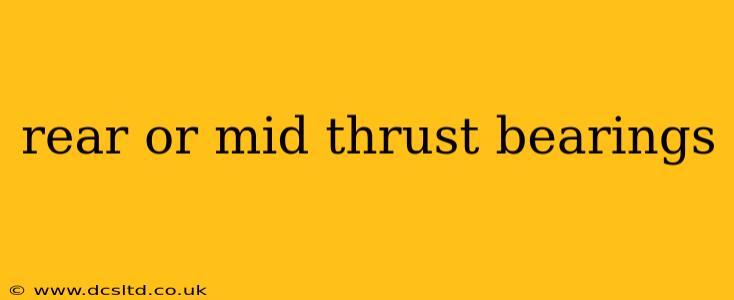Choosing the right thrust bearing is crucial for any rotating machinery, as it directly impacts performance, efficiency, and longevity. Two common types are rear thrust bearings and mid-thrust bearings. This article will delve into the differences between these two, helping you understand their applications, advantages, and disadvantages to make informed decisions for your specific needs.
What is a Thrust Bearing?
Before we compare rear and mid-thrust bearings, let's establish a fundamental understanding. A thrust bearing is a type of bearing designed to support axial loads – forces acting parallel to the shaft's axis. This is in contrast to radial bearings, which primarily handle loads perpendicular to the shaft. Thrust bearings are essential in applications where axial movement needs to be controlled or prevented, such as in pumps, turbines, and gearboxes.
Rear Thrust Bearings: A Detailed Look
Rear thrust bearings, as the name suggests, are positioned at the end of a shaft, typically supporting the axial load from one direction. They are commonly used in simple machine designs where the axial load is predominantly in one direction.
Advantages of Rear Thrust Bearings:
- Simplicity: Generally simpler in design and easier to install compared to mid-thrust bearings.
- Cost-effectiveness: Often less expensive due to their simpler design and manufacturing processes.
- Easy Maintenance: Access for maintenance and inspection is typically straightforward.
Disadvantages of Rear Thrust Bearings:
- Limited Load Capacity: May not be suitable for high axial loads or applications with significant fluctuating loads.
- Potential for Shaft Deflection: The entire axial load is concentrated at one point, potentially leading to shaft deflection under heavy loads.
- Not Suitable for Bi-directional Loads: Only effectively handles loads from one direction; unsuitable for applications with reversing axial forces.
Mid-Thrust Bearings: Understanding their Functionality
Mid-thrust bearings, in contrast, are located somewhere along the shaft's length, rather than at the end. They're designed to handle axial loads from both directions or to support a load that is distributed along the shaft.
Advantages of Mid-Thrust Bearings:
- Higher Load Capacity: Can support significantly larger axial loads compared to rear thrust bearings due to better load distribution.
- Reduced Shaft Deflection: Distributed load reduces stress on the shaft, minimizing deflection and extending its lifespan.
- Suitable for Bi-directional Loads: Effectively handles axial loads from both directions, making them ideal for applications with reversing loads.
- Improved Stability: Enhanced stability and reduced vibration compared to rear-mounted counterparts.
Disadvantages of Mid-Thrust Bearings:
- More Complex Design: More intricate design and manufacturing processes, resulting in higher costs.
- More Difficult Installation: Installation can be more challenging due to their location and complexity.
- Potentially More Difficult Maintenance: Access for maintenance and inspection can be more difficult depending on the machine's design.
Which Type of Thrust Bearing is Right for You?
The choice between a rear or mid-thrust bearing depends heavily on the specific application and its requirements. Consider the following factors:
- Magnitude and Direction of Axial Load: For low, unidirectional loads, a rear thrust bearing may suffice. High or bidirectional loads necessitate a mid-thrust bearing.
- Shaft Design and Support Structure: The shaft's design and the machine's overall structure influence the feasibility and effectiveness of each type.
- Budgetary Constraints: While mid-thrust bearings offer superior performance, they usually command a higher price.
- Maintenance Requirements: Consider the accessibility for maintenance and the potential downtime associated with each bearing type.
Frequently Asked Questions (FAQ)
This section addresses some common questions regarding rear and mid-thrust bearings.
What are the different types of thrust bearings?
Several types exist, including ball thrust bearings, roller thrust bearings (cylindrical, tapered, spherical), and fluid film thrust bearings (hydrodynamic and hydrostatic). The choice depends on factors like load, speed, and required precision.
How do I choose the right size thrust bearing?
Bearing selection involves carefully considering the application's load requirements, operating speed, and environmental conditions. Consult bearing manufacturer catalogs and engineering handbooks for detailed sizing procedures.
What is the lifespan of a thrust bearing?
Bearing lifespan depends on numerous factors, including load, speed, lubrication, and operating temperature. Proper installation, maintenance, and lubrication significantly extend its lifespan.
How much do thrust bearings cost?
The cost varies considerably based on size, type, material, and manufacturer. Simple rear thrust bearings are generally cheaper than more complex mid-thrust designs.
Where can I find more information on thrust bearing selection?
Many resources are available online and in engineering literature, including manufacturer websites and technical handbooks. Consulting with a bearing specialist is always recommended for complex applications.
By carefully considering these factors and addressing the frequently asked questions, you can select the optimal thrust bearing for your application, ensuring optimal performance, reliability, and longevity of your machinery. Remember, consulting with a bearing specialist is always recommended for complex or critical applications.
